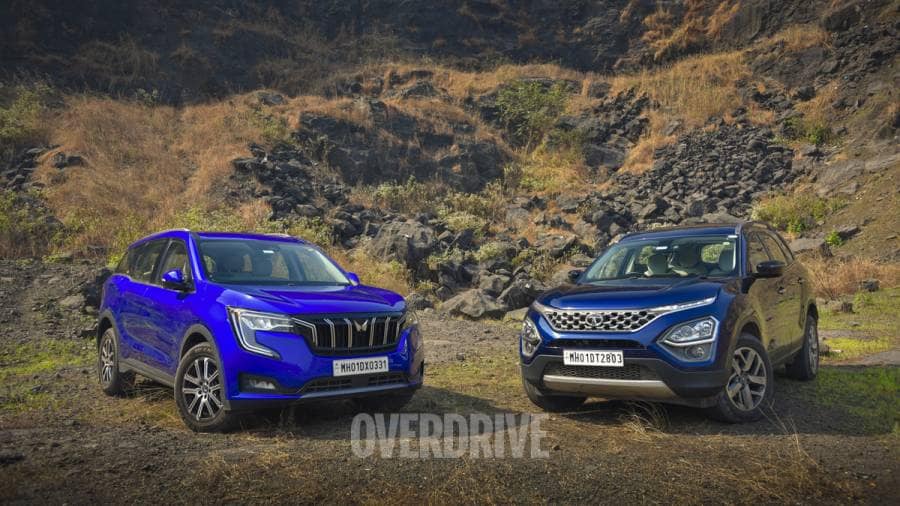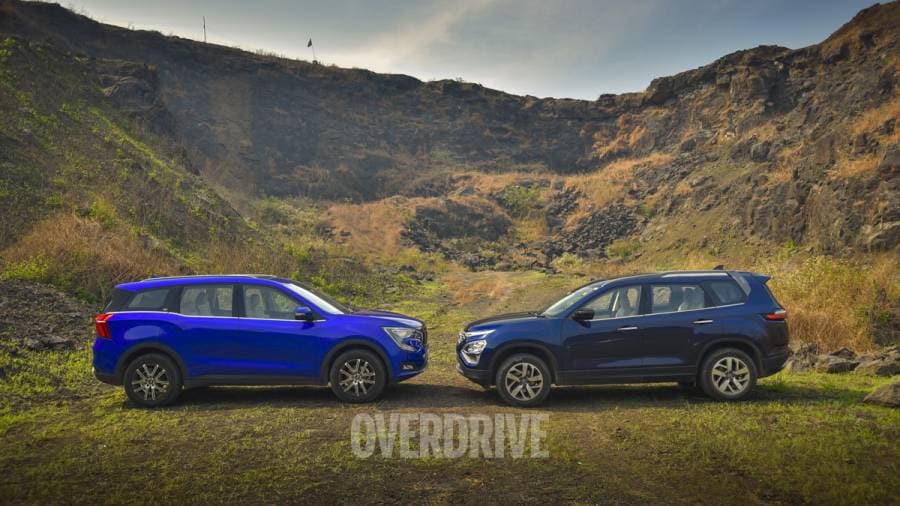Mahindra XUV700 vs Tata Safari comparison review
The three-row SUV. The timeless formula for the ultimate family mover. After all the first ever SUVs in the world were fashioned out of station wagons, with added abilities courtesy four-wheel drive powertrains. Fast forward to the present and in India at least, the formula's been simplified a bit to exclude 4x4. Why? The market doesn't buy it, apparently. At least not when it comes to going from a keyboard warrior versus actually walking into a showroom. So, with the Tata Safari, a resurrection of one of India's earliest SUV name tags, we have a three-row adaptation of the Harrier, but minus any form of all-wheel drive… because what the market buys, the market gets. On the other hand, with the Mahindra XUV700, an all-new car that can be viewed as the next-gen XUV500 but named differently to position it over an upcoming new model, there's a return to the all-wheel drive capability that was once offered on the XUV. And a tonne of tech. Mahindra's taken their time with the XUV700, and it shows. On the face of it, there's very little to dislike about the 700. Apart from the way it looks, so that's as good a place as any to start…

It's pretty obvious that the 700 was meant to be a next-gen 500, an SUV which never really appealed to me stylistically but I may be in the minority here. I would imagine positioning strategy left a spot for an alternatively branded 5-seater, sort of the reverse of what Hyundai and Tata did with the Creta/Alcazar and Harrier/Safari. Some of the ungainly surfaces on the older 500 have been smoothed out (kink in the body line over the rear wheels, I'm looking at you) but there still are a few parts that seem overdone. Like the tail lamps, for example. Though the pop-out door handles are a premium touch, I can't help but feel contrast finish regular door handles would've helped break up the vast door surfaces.

Next to the Safari, the XUV700 doesn't quite have the same road presence. This, even though the 700 is actually the longer SUV (4,695x1,890x1,755mm), with a marginally longer wheelbase (2,750mm) versus the Safari (4,661x1,894x1,786mm) on a 2,741mm long wheelbase. It could be the fact that the Safari is taller that helps it, or that the leading edge of the hood on the Safari is marginally higher, aided by the layers made up of the grille, air dam and faux skid plate. That said, the 700 does appear to have a larger glass area, versus the Safari's more aggressive front-rear taper in the glasshouse. The integrated roof rails in the Safari are a nice touch, though. It would appear the wheels play a part here too, with the Safari's alloy wheels looking more substantial and chunky with the 235/60 18-inch tyres filling out the wheel wells better. The polished/painted spokes on the similarly-sized alloys on the 700 just maybe a little too thin and elegant looking for an SUV of this size. And when viewed from the rear, the LED tail light signature on the 700 are distinctive at night, but the Safari definitely shows its Land Rover genes with its split LED light signature placed high up.
Speaking of lighting, the 700 has a huge advantage in its LED headlights and auto booster tech; these lights are amongst the very best we've ever driven with, in turning night to day! The Safari's halogen projectors are adept by themselves but aren't in the same league when it comes to throw and reach.
Mahindra XUV700 vs Tata Safari interior space, ambience and featuresA quick summary between these two SUV's cabins would be that the 700 feels airier and more modern, by virtue of all the tech and the lighter colours, while the Safari feels more spacious in all of the rows of seating, apart from feeling more SUV-like. Especially considering you really do sink into the large seats, and have a substantial dash laid out in front of you. Another important point to note would be that the Safari is the only one with a choice of captain seats for the second row, which are vastly more comfortable than the 700's second row bench.
Specifically, the 700 impresses with its Mercedes-inspired touchscreen infotainment and full-digital instrumentation screens stretched across half the dash, which offers a surprising extent of customisation and fluidity to the graphics and execution. That's not to say that it doesn't have its share of glitches, with our test car's wired Android Auto/Apple CarPlay not having been activated yet, with no official word on when that software patch will come through. There also appeared to be instances where one of the door handles wouldn't retract after locking but those were few and far in between. As an experience, the 700 delivers one that feels like it could be a segment above, with near-everything thought of â€" even the sunshades can be extended for better coverage! That assessment stands largely true, if not for some of the plastics somewhat letting it down, especially in the door handle area, and on the lower dash. It also felt like the seats had a bit too much lumbar support for me.
Climbing into the Safari after feels like you've got into an older SUV, which is fair. But to the Safari's credit it doesn't feel bad, just… different. It's more old-school, what with the tiny touchscreen infotainment system (wired CarPlay glitched on us as well), smaller ana-digi instrumentation and the like. Not to mention the comically large steering boss up front and centre when you're in the driver's seat. Updated top variant models have wireless smartphone charging and wireless integration, with a big plus being seat ventilation on the top trim for four captain seats across the first two rows! Plastics between the two feel similar, with the Safari feeling more premium in some areas (like the polished door pull handles, leather trim on dash), while the 700 pulls back in others, with the long, long list of features being a key differentiator. The audio system performance in either is pretty good too, with the JBL setup in the Safari delivering good body and clarity, but the Sony setup in the 700 goes a little further in separation thanks to the fancy DSPs and 3D surround presets.
As for second row comfort, the Safari pulls ahead with more comfortable captain seats, which are set higher relative to the first row, with easier access to the third row, which again has more knee room, headroom and a more comfortable angle of recline, even for adults over reasonably long range distances. In the 700, the third row is much better suited to children.
Boot space in either is limited with all rows up but the 700 offers just a bit more, which could be useful for stuffing soft bags in.
Mahindra XUV700 vs Tata Safari safety features
The 700 pulls out an advantage here, with seven airbags (curtain airbags extend to the third row) to the Safari's six, apart from all the ADAS tech, which includes forward collision warning/avoidance, automatic emergency braking, and lane keep assist. Only the 700 carries a GNCAP rating, of an impressive 5 stars.
Mahindra XUV700 vs Tata Safari engine, performance and efficiencyApart from the on-paper advantage the 700 has over the Safari, with a higher displacement 2.2-litre diesel engine, with more power (185PS vs 170PS) and torque (450Nm vs 350Nm), the engine also is marginally quieter and smoother, though that says more about the Safari's engine that it does this. Again, that slightly more gruff engine note on the Safari goes towards its more dyed-in-the-wool SUV feel that one could get used to very easily, but there's no denying the 700 feels more refined and less vibey.
In regular driving you'd be hard pressed to find faults with either, or the 6-speed torque converter automatics in either, though it does feel like the Safari's gearbox (a Hyundai unit) might just get the edge in intuitiveness in selecting gears at lower speeds, with marginally quicker downshifts when an overtake calls for it. Both these SUVs shift up around the 2,000rpm mark to keep up with city traffic, and roll-on performance was near identical surprisingly. Where the 700 stretches ahead is in outright performance, being over two seconds quicker in the 0-100kmph dash with a time of 9.3s versus the Safari's 11.6s! There's a little more in reserve at the top end of the rev range in the 700, and it's noticeable when you really wring these SUVs out. Even if you weren't, the 700 does feel like it gets up to highway speeds just that little bit more effortlessly than the Safari, especially if you wanted to get back up to speed quickly.
Both are equally relaxed on the highway â€" at a steady speed of 120kmph, they're both spinning just under 2,000rpm. Despite that, the 700 posts better fuel efficiency figures. On the highway the difference isn't as vast, with the 700 at 15.8kmpl versus the Safari's 15kmpl. In the city that gap widens, at 12.5kmpl versus 10.3kmpl in the 700's favour.
Mahindra XUV700 vs Tata Safari ride and handlingSurprise, surprise â€" the Safari has the heavier steering, and feels more SUV-like to drive around, which means it can feel a little oversized to pilot around narrower lanes, while the 700 feels almost car-like. That slightly ponderous nature of the Safari, especially at lower speeds, could be seen as a plus point to some people; I certainly didn't find it getting in my way even through crowded streets. But driven back-to-back with the 700, it does feel like it could do with a little more assistance at low speeds, often needing both hands to feed the wheel through U-turns, while the 700 could easily be swung around single handed, if you were so inclined.
The heavier steering on the Safari does feel a little vague when you get to corners, but it does feel like it weighs up more predictably than the 700, which struggles to transmit feedback through all its assistance. We'll talk about ride before we get to outright handling, since that bears so heavy on it. The 700 has the better judged ride, thanks to its frequency selective damping and sophisticated independent rear suspension setup, smoothing out even the worst roads. The Safari will do the same, make no mistake, but with a near constant underlying sense of micro-vibrations that you really only feel when you don't feel them over the same stretch of road in the 700.
As a result, the 700 tips into corners with marginally more lean and body roll than the Safari, holds its line well enough, but doesn't feel as confident as the Safari does when you really throw it in. Not that most owners are going to be doing that, but the Safari has the slight edge here. Cornering at normal speeds, the 700 and the Safari are close enough that you (and your passengers) will be happy.
Mahindra XUV700 vs Tata Safari verdict
Objectively, the XUV700 scores higher in almost all areas of our consideration, and is the wiser pick, the more modern pick, the smoother drive; the list goes on. If you don't really need the third row space, or if you can reconcile with its styling. But, the Safari isn't far behind, and to my eyes, looks better. In a lot of ways the Safari's faults are more like quirks. But more importantly â€" it's available! The 700's waiting times could put a lot of people off and unless Mahindra can find a way to get ahead of the incredible demand, a lot of people just may settle for the Safari. If anything, this is the perfect time for Tata to update a few key areas to make for a more compelling package.
Photography by Anis Shaikh
Also read,ÂÂ
2021 Mahindra XUV700 first drive review
2021 Tata Safari road test review